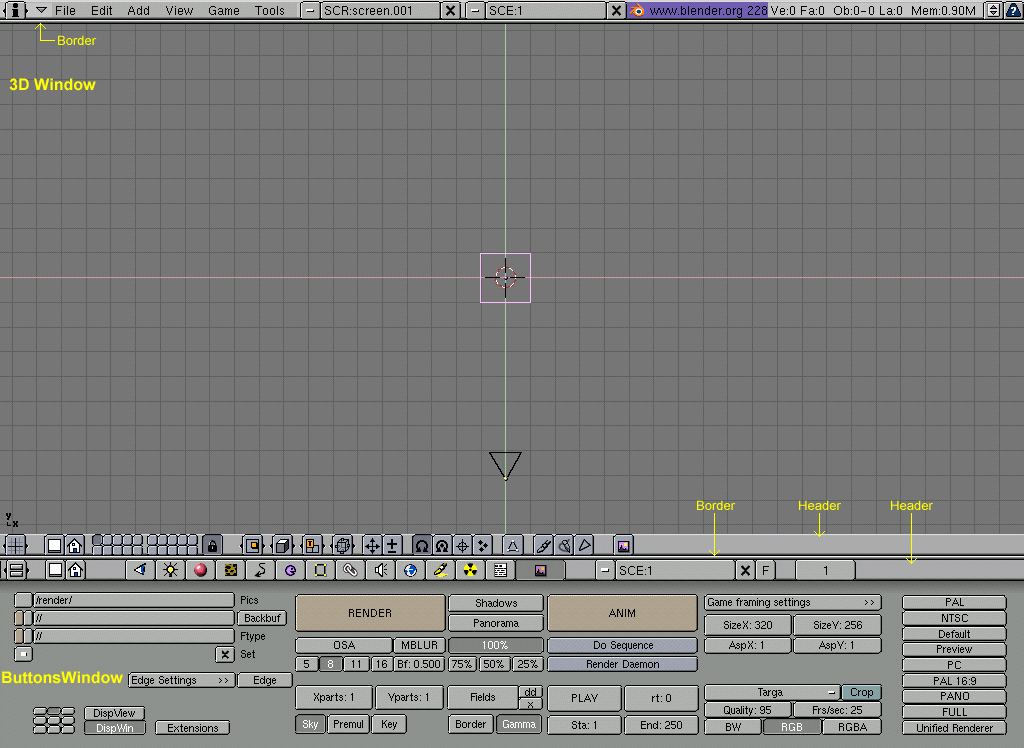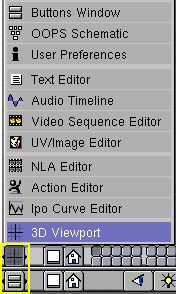Understanding the interface
By Martin Kleppmann
If you are new to Blender, it is important to get a good grip of the user interface before starting on modelling. This is because the concepts are quite non-standard - it differs from other 3D software packages, and Windows users especially will need to get used to the different handling of controls. But this interface concept is in fact one of Blender's great strengths: once you have found out how it works, it enables you to work exceedingly quickly and productively.
Blender's interface concept
The interface is the two way means of interaction between the user and the code. The user communicates with the code via the keyboard and the mouse, the code gives feedback via the screen and its windowing system.
Keyboard and mouse
Blender's interface makes use of three mouse buttons and a wide range of hotkeys (for a quick, compact list see the appendix called Hotkeys Quick Reference Table, for a complete in-depth discussion refer to Part IX in Blender Documentation). If your mouse has only two buttons, you can activate an emulation of the middle mouse button (the Section called User preferences describes how to do this). A mouse wheel can be used, but it is not necessary, as there are also appropriate keyboard shortcuts.
This manual uses the following conventions to describe user input:
The mouse buttons are called LMB (left mouse button), MMB (middle mouse button) and RMB (right mouse button).
If your mouse has a wheel, MMB refers to clicking the wheel as if it were a button, while MW means rolling the wheel.
Hotkey letters are named by appending KEY to the letter, e.g. GKEY refers to the letter g on the keyboard. Keys may be combined with the modifiers SHIFT, CTRL and/or ALT. For modified keys the KEY suffix is generally dropped e.g. CTRL-W or SHIFT-ALT-A.
NUM0 to NUM9, NUM+ etc. refer to the keys on the separate numeric keypad. NumLock should generally be switched on.
Other keys are referred to by their names, e.g. ESC, TAB, F1 to F12.
Other special keys of note are the arrow keys, UPARROW, DOWNARROW etc.
Because Blender makes such extensive use of both mouse and keyboard, a "golden rule" evolved amongst users: have one hand on the mouse and the other on the keyboard! If you normally use a keyboard that is significantly different from the English layout, you may want to think about changing to the English or American layout for the time you work with Blender. The most frequently used keys are grouped so that they are reachable by the left hand in standard position (index finger on FKEY) on the English keyboard layout. This assumes that you use the mouse with your right hand.
The window system
Now it's time to start Blender and begin playing around.
Figure 1 shows the screen you should get after starting Blender (except for the yellow text and arrows). At default it is separated into three windows: the main menu at the top, the large 3D Window and the Buttons Window at the bottom. Most windows have a header (the strip with a lighter grey background containing icon buttons - for this reason we will also refer to the header as the window ToolBar); if present, the header may be located at the top (as with the Buttons window) or the bottom (as with the 3D Window) of a window's area.
If you move the mouse over a window, note that its header changes to a lighter shade of grey. This means that it is "focused", i.e. all hotkeys you press will now affect the contents of this window.
The window system is easily customizable to your needs and wishes. To create a new window, you can split an existing one in half. Do this by focusing the window you want to split (move the mouse into it), clicking the border with MMB or RMB, and selecting "Split Area" (Figure 2). You can now set the new border's position by clicking with LMB, and cancel by pressing ESC. The new window will start as a clone copy of the window you split, but can then be set to do new things, like displaying the scene from a different perspective.
Create a new vertical border by choosing "Split Area" from a horizontal border, and vice versa. You can resize each window by dragging a border with LMB. To reduce the number of windows, click a border between two windows with MMB or RMB and choose "Join Areas". The resulting window receives the properties of the previously focused window.
You can set a header's position by clicking RMB on the header and choosing "Top" or "Bottom". It is also possible to hide the header by choosing "No Header", but this is only advisable if you know all the relevant hotkeys. A hidden header can be shown again by clicking the window's border with MMB or RMB and selecting "Add Header".
Window types
Each window frame may contain different types and sets of information, depending what you are working on: 3D models, animation, surface materials, Python scripts etc. The type for each window can be selected by clicking its header's leftmost button with LMB (Figure 3).
The functions and usage of the respective window types will be explained at the relevant places in this manual. For now we only need the three window types that are already provided in Blender's default scene:
- 3D viewport
Provides a graphical view into the scene you are working on. You can view from any angle with a variety of options; see the Section called Navigating in 3D space for details. Having several 3D viewports on the same screen can be useful to watch your changes from different perspectives at the same time.
- Buttons window
Contains most tools for editing objects, surfaces, textures, lights and much more. You will constantly need this window if you don't know absolutely all hotkeys off by heart, but having it twice would be useless.
- User preferences (Main menu)
This window is usually hidden, so that only the menu part is visible - see the Section called User preferences for details. Compared to other software packages, this menu need hardly be used, though.
A feature of windows that sometimes comes in handy for precise editing is maximizing to full screen: if you press the appropriate button in the header (the second from the left in Figure 3) or the hotkey CTRL-DOWNARROW, the focused window will extend to fill the whole screen. To return to normal size, press the button again or CTRL-UPARROW.
Button types
Blender's buttons are more exciting than those in most other user interfaces. This is largely due to the fact that they are vectorial and drawn in OpenGL, hence elegant and zoomable.
There are several kind of buttons:
Operation Button. These are buttons that perform an operation when they are clicked (with LMB, as all buttons). They can be identified by their brownish colour (Figure 4).
Operation Button. Toggle buttons come in various sizes and colours (Figure 5). The colours green, violet and grey do notchange functionality, they just help the eye to group them and recognize contents of the interface quicker. Clicking this type of button does not perform any operation, but only toggles a state as "on" or "off".
Some buttons also have a third state that is identified by the text turning yellow (the Ref button in Figure 5). Usually the third state means "negative", and the normal "on" state means "positive".
Radio Buttons. Radio buttons are particular groups of mutually exclusive Toggle buttons. No more than a single Radio Button of a given group can be "on" at a time.
Num Buttons. Number buttons (Figure 7) can be identified in that their caption contains a colon followed bya number. Some number buttons also contain a slider. Number buttons have several ways of handling: To increase the value, click LMB on the right half of the button, to decrease it, on the left half. To change the value in a wider range, hold down LMB and drag the mouse to the left or right. If you hold CTRL while doing this, the value is changed in discrete steps; if you hold SHIFT, the control is finer.
You can enter a value via the keyboard by holding SHIFT and clicking LMB. Press SHIFT-BACKSPACE to clear the value, SHIFT-LEFTARROW to move the cursor to the beginning and SHIFT-RIGHTARROW to move the cursor to the end. By pressing ESC you can restore the original value.
Menu Buttons. Menu buttons are used to choose from dinamically created list. Their principaluse is to link datablocks to each other. (Datablocks are structures like Meshes, Objects, Materials, Textures etc.; by linking a Material to an Object, you assign it.) An example for such a block of buttons is shown in Figure 7. The first button (with the dash) opens a menu that lets you select the datablock to link to by holding down LMB and releasing it over the requested item. The second button displays the type and name of the linked datablock and lets you edit the name it after clicking LMB. The "X" button clears the link; the "car" button generates an automatic name for the datablock and the "F" button specifies whether the datablock should be saved in the file even if it is unused.
 | Unlinked objects |
|---|---|
Unlinked data is not lost untill you quit Blender. This is a powerfull Undo feature. if you delete an object the material assigned to it becomes unlinked,but is still there! You just have to re-link it to another object or press the "F" button. |
Screens
Blender's flexibility with windows lets you create customized working environments for different tasks e.g. modelling, animating and scripting. It is often useful to quickly switch between different environments within the same file. This is possible by creating several screens: All changes to windows as described in the Section called The window system and the Section called Window types are saved within one screen, so if you change your windows in one screen, other screens won't be affected. But the scene you are working on stays the same in all screens.
Three different default screens are provided with Blender; they are available via the SCR link buttons in the menu/preferences window shown in Figure 8. To change to the alphabetically next screen, press CTRL-RIGHTARROW; to change to the alphabetically previous screen, press CTRL-LEFTARROW.
Scenes
It is also possible to have several scenes within the same Blender file; they may use one another's objects or be completely separate from another. Scenes can be selected and created with the SCE link buttons in the menu/preferences window (Figure 9).
When you create a new scene, you can choose between four options about its contents:
Empty creates an empty scene (surprise).
Link Objects creates the new scene with the same contents as the currently selected scene. Changes in one scene will also modify the other.
Link ObData creates the new scene based on the currently selected scene, with links to the same meshes, materials etc. This means you can change objects' positions and related properties, but modifications on the meshes, materials etc. will also affect other scenes unless you manually make single-user copies.
Full Copy does what it says and creates a fully independent scene with copies of the currently selected scene's contents.








